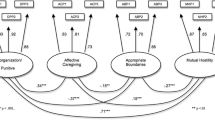Abstract
This paper describes development of a retrospective measure of childhood exposure to parental dyscontrol related to specific conditions such as a parent's drinking, anger, or other negative emotional states (e.g., stress, anxiety, depression). A 45-item questionnaire, the Dyscontrol Experiences Questionnaire (DEQ), was designed to assess individuals' childhood experiences with parental loss of control. Two student samples (n = 465 and n = 536) completed a battery of self-report measures. Responses were used to examine the psychometric properties of the DEQ. Factor analysis revealed three lower-order factors accounting for 54.4% of the variance in DEQ item scores. Cronbach's coefficient alphas indicated acceptable internal consistency. Moderate intercorrelations with two other retrospective measures of childhood experiences suggested construct validity. Moderate intercorrelations with two measures of psychological distress suggested predictive validity. In summary, initial psychometric testing of the DEQ suggests it is a reliable and valid tool for investigating an important developmental antecedent of adult psychological distress.
Similar content being viewed by others
REFERENCES
American Psychiatric Association. (1994) Diagnostic and statistical manual of mental disorders (4th ed.). Washington, DC: Author.
Bandura, A. (1986). Social foundations of thought and action: A social cognitive theory. Upper Saddle River, NJ: Prentice-Hall.
Barlow, D. H. (1988). Anxiety and its disorders. New York: Guilford Press.
Barlow, D. H., Chorpita, B. F., & Turovsky, J. (1996). Fear, panic, anxiety, and disorders of emotion. In D. A. Hope (Ed.), Nebraska Symposium on Motivation: Perspectives on anxiety, panic, and fear Vol. 43. (pp. 251-328). Lincoln: University of Nebraska Press.
Beck, A. T., Steer, R. A., & Brown, G. K. (1996). Manual for the Beck Depression Inventory—second edition (BDI-II). San Antonio: The Psychological Corporation.
Brewin, C. R., Andrews, B., & Gotlib, I. H. (1993). Psychopathology and early experience: A reappraisal of retrospective reports. Psychological Bulletin, 113, 82-98.
Carton, J. S., & Nowicki, S. (1994). Antecedents of individual differences in locus of control reinforcement: A critical review. Genetic, Social, and General Psychology Monographs, 120, 31-81.
Cattell, R. B. (1966). The scree test for the number of factors. Multivariate Behavioral Research, 1, 245-276.
Chorpita, B. F. (2001). Control and the development of negative emotion. In M. W. Vasey & M. R. Dadds (Eds.), The developmental psychopathology of anxiety (pp. 112-142). New York: Oxford University Press.
Chorpita, B. F., & Barlow, D. H. (1998). The development of anxiety: The role of control in the early environment. Psychological Bulletin, 124, 3-21.
Comrey, A. L., & Lee, H. B. (1992). A first course in factor analysis (2nd ed.). Hillsdale, NJ: Erlbaum.
Ehlers, A. (1993). Somatic symptoms and panic attacks: A retrospective study of learning experiences. Behaviour Research and Therapy, 31, 269-278.
Floyd, F. J., & Widaman, K. (1995). Factor analysis in the development and refinement of clinical assessment instruments. Psychological Assessment, 7, 286-299.
Frankfort-Nachmias, C., & Nachmias, D. (1996). Research methods in the social sciences (5th ed.). New York: St. Martin's Press.
Gray, J. A., & McNaughton, N. (2000). The neuropsychology of anxiety: An enquiry into the functions of the septo-hippocampal system. New York: Oxford University Press.
Jones, J. W. (1983). The Children of Alcoholics Screening Test (CAST). Chicago, IL: Camelot Unlimited.
Longman, R. S., Cota, A. A., Holden, R. R., & Fecken, G. C. (1989). A regression equation for the parallel analysis criterion in principal components analysis: Mean and 95th percentile eigenvalues. Multivariate Behavioral Research, 24, 59-69.
MacPherson, P. S. R., Stewart, S. H., & McWilliams, L. A. (2001). Parental problem drinking and anxiety disorder symptoms in adult offspring: Examining the mediating role of anxiety sensitivity components. Addictive Behaviors, 26, 917-934.
Meier, S. T. (1994). The chronic crisis in psychological measurement and assessment: A historical survey. San Diego: Academic Press.
Mineka, S., & Kelly, K. (1989). The relationship between anxiety, lack of control, and loss of control. In A. Steptoe & A. Appels (Eds.), Stress, personal control, and worker health. Brussels: Wiley.
Nunnally, J. C. (1978). Psychometric theory (2nd ed.). New York: McGraw-Hill.
Parker, G. (1983). Parental overprotection: A risk factor in psychosocial development. New York: Grune & Stratton.
Parker, G., Tupling, H., & Brown, L. B. (1979). A Parental Bonding Instrument. British Journal of Medical Psychology, 52, 1-10.
Rapee, R. M. (1997). Potential role of childrearing practices in the development of anxiety and depression. Clinical Psychology Review, 17, 47-67.
Scher, C. D., Stein, M. B., Ingram, R. E., Malcarne, V. L., & McQuaid, J. R. (2002). The Parent Threat Inventory: Development, reliability, and validity. Child Abuse and Neglect, 26, 207-225.
Schneewind, K. A. (1995). Impact of family processes on control beliefs. In A. Bandura (Ed.), Self-efficacy in changing societies (pp. 114-1148). New York: Cambridge University Press.
Spielberger, C. D., Gorsuch, R. L., Lushene, R. E., Vagg, P. R., & Jacobs, G. A. (1983). Manual for the State–Trait Anxiety Inventory. Palo Alto, CA: Consulting Psychologists Press.
Tabachnick, B. G., & Fidell, L. S. (1989). Using multivariate statistics (2nd ed.). New York: HarperCollins.
Thurstone, L. L. (1947). Multiple-factor analysis: A development and expansion of the vectors of mind. Chicago: University of Chicago Press.
Watt, M., Stewart, S. H., & Cox, B. J. (1998). A retrospective study of the origins of anxiety sensitivity. Behaviour Research and Therapy, 36, 505-525.
Whitehead, W. E., Busch, C. M., Heller, B. R., & Costa, P. T. (1986). Social learning influences on menstrual symptoms and illness behaviour. Health Psychology, 5, 13-23.
Zwick, W. R., & Velicer, W. F. (1986). Comparison of five rules for determining the number of components to retain. Psychological Bulletin, 99, 432-442.
Author information
Authors and Affiliations
Corresponding author
Rights and permissions
About this article
Cite this article
Watt, M.C., Stewart, S.H. Dyscontrol Experiences Questionnaire: Development, Reliability and Validity. Journal of Psychopathology and Behavioral Assessment 25, 155–165 (2003). https://doi.org/10.1023/A:1023520906533
Issue Date:
DOI: https://doi.org/10.1023/A:1023520906533




